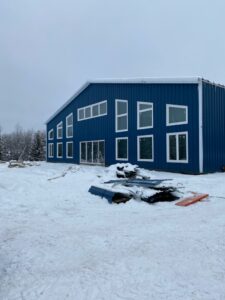Why Power Steel Buildings Are Ideal for Canadian Weather
Building in Canada requires materials that can withstand extreme weather conditions. With severe winters, heavy snowfall, and fluctuating temperatures throughout the year, construction materials and designs need to be exceptionally durable. Steel buildings offer numerous advantages, making them an excellent choice for Canada’s varied and challenging climate.
Robustness in Severe Winters
1. High Snow Load Capacity
In Canada, buildings must be able to handle substantial snow loads. Accumulated snow can be very heavy, especially in regions with harsh winters. Steel buildings are specifically designed to manage these loads efficiently. The robust nature of steel ensures that roofs and supports remain sturdy, preventing collapse or structural damage under heavy snow. Advanced engineering methods allow for precise calculations of snow load capacities, ensuring that steel buildings comply with or surpass local building codes and safety standards.
At Power Steel Buildings, we recognize that snow load requirements differ across various regions. We conduct thorough assessments to ensure each building we supply is tailored to meet the specific demands of your area. Whether your region experiences moderate snowfall or severe winter storms, we will design your steel building to handle the unique challenges posed by your local climate.
2. Stability Amidst Temperature Fluctuations
Canadian winters bring not only snow but also significant temperature fluctuations. Steel buildings excel in resisting these changes. Unlike other materials that may expand and contract with temperature variations, steel maintains its structural integrity, reducing the risk of cracks or warping. This stability is crucial for extending the building’s lifespan and reducing maintenance costs over time.
Flexibility and Efficiency
3. Fast and Efficient Construction
Steel buildings offer a streamlined construction process, which is particularly beneficial in regions with shorter construction seasons due to weather conditions. Prefabricated steel components can be quickly assembled on-site, minimizing construction time and labor costs. This efficiency ensures that buildings are completed faster, allowing businesses and homeowners to start using the space without unnecessary delays.
Long-Term Advantages
4. Low Maintenance Requirements
Steel buildings require much less maintenance compared to traditional construction materials. They are resistant to pests, rot, and mold, which are common issues in wooden structures. Moreover, steel does not need frequent painting or treatment, further reducing long-term maintenance expenses. This durability leads to lower operating costs and a higher return on investment over the building’s lifespan.


